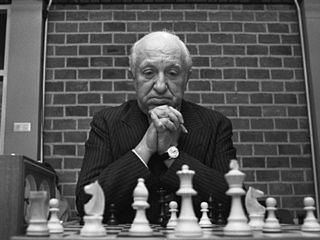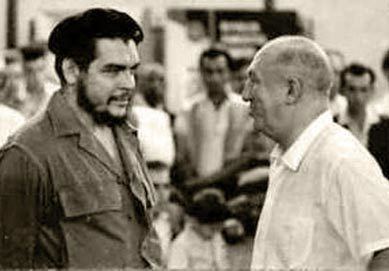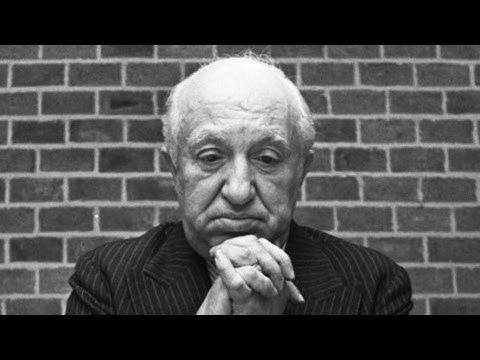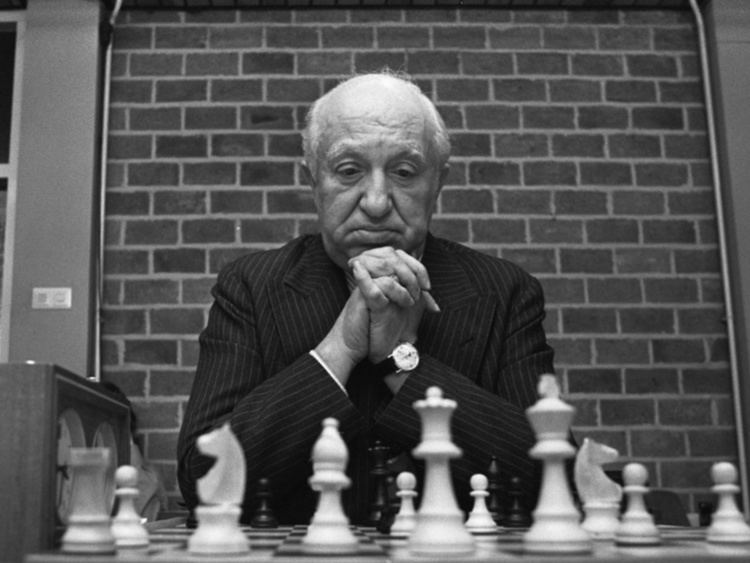Full name Mojsze Mendel Najdorf Role Chess Player Name Miguel Najdorf | Country PolandArgentina | |
 | ||
Died July 4, 1997, Malaga, Spain | ||
Amazing chess game brilliancy glucksberg vs miguel najdorf dutch defence dual commentary
Miguel Najdorf (born Mojsze Mendel Najdorf) (15 April 1910 – 4 July 1997) was a Polish-Argentine chess grandmaster. Originally from Poland, he was in Argentina when World War II began in 1939, and he stayed and settled there. He was a leading world player in the 1940s and 1950s, and is also known for the Najdorf Variation, one of the most popular of all chess openings.
Contents
- Amazing chess game brilliancy glucksberg vs miguel najdorf dutch defence dual commentary
- Evolution of chess style 167 david bronstein vs miguel najdorf budapest candidates 1950
- Early life in Poland
- Move to Argentina
- Blindfold chess
- 1940s
- World Championship contender
- Later career
- Olympiad performances
- Contributions
- Notable games
- Personal life
- References

Evolution of chess style 167 david bronstein vs miguel najdorf budapest candidates 1950
Early life in Poland

Najdorf was tutored first by Dawid Przepiórka, then by Savielly Tartakower, the latter of whom he always referred to as "my teacher".

At the beginning of his chess career, in 1930, Najdorf defeated Glücksberg in a famous game known as "The Polish Immortal". In 1930, he tied for 6th–7th at the Warsaw Championship, an event won by Paulino Frydman. In 1931, he took second in Warsaw, behind Frydman. In 1932, he tied for 9th–10th in Warsaw. In 1933, he won in Warsaw (Quadrangular). In January 1934, he finished second to Rudolf Spielmann, in Warsaw. In summer 1934, he lost a match against Ored Karlin (+1–2=1). In 1934, he won the Warsaw championship. In 1935, he tied for 2nd–4th with Frydman and Henryk Friedman, behind Tartakower, in the 3rd Polish Chess Championship, held in Warsaw. Afterward, Najdorf won a match against Tartakower in Toruń (+2–1=2). In 1936, he tied for first with Lajos Steiner in the Hungarian Championship. In 1937, he took third at the 4th Championship of Poland in Jurata. In 1937, he won in Rogaška Slatina (Rohitsch-Sauerbrunn). In 1938, he tied for 10th–12th in Łódź. In 1939, he took sixth in Margate, and won in Warsaw.

Najdorf represented Poland in four pre-war Chess Olympiads. In August 1935, he played third board in the 6th Chess Olympiad in Warsaw (+9–2=6). In August 1936, he was second board in 3rd unofficial Chess Olympiad organised by the German Chess Federation in Munich (+14–2=4). In June/July 1937, he played at second board in the 7th Chess Olympiad in Stockholm (+5–3=7). In the 1939 Olympiad, Najdorf played second board for Poland and achieved a score of +12−2=4, winning a gold medal.
Move to Argentina
During the 8th Chess Olympiad in Buenos Aires in August/September 1939, World War II broke out. Najdorf was Jewish, as were two of his teammates, Tartakower and Frydman. He decided to stay and settle in Argentina (as did many others), becoming an Argentine citizen in 1944.
His wife, daughter, parents and four brothers all died in the Holocaust. Najdorf later remarried and had a daughter.
Blindfold chess
Najdorf set world records for simultaneous blindfold chess. He played a record 40 opponents in 1943, and increased the record to 45 in 1947. This record stood until 2011.
He set these records in the hope that the news would be reported in Europe and his family would come to Argentina to meet him, though none ever were able to.
1940s
In September 1939, after the Olympiad, Najdorf tied for first with Paul Keres at Buenos Aires (Círculo de Ajedrez); the two scored 8½/11. In 1941, he took second, after Gideon Ståhlberg at Mar del Plata, with 12½/17. Later in 1941, he finished equal first with Stahlberg at Buenos Aires, the two scoring 11/14. In 1942, he won at Mar del Plata, with 13½/17, ahead of Ståhlberg. In 1943, he was second at Mar del Plata, behind Stålhberg, scoring 10/13. In 1943, he won at Rosario. In 1944, he won at La Plata, with 13/16, ahead of Ståhlberg. In 1944, he tied for first with Herman Pilnik at Mar del Plata, with each scoring 12/15. In 1945, he won at Buenos Aires (Roberto Grau Memorial), with 10/12, ahead of Ståhlberg and Carlos Guimard. He took second place at Viña del Mar 1945, with 10½/13, behind Guimard, then won Mar del Plata 1945 with 11/15, ahead of Ståhlberg, and repeated at Mar del Plata 1946 with 16/18, ahead of Guimard and Ståhlberg. He also won at Rio de Janeiro 1946.
After World War II ended, organized chess resumed in the international arena, particularly in war-stricken Europe. In 1946, Najdorf tied for 4th–5th with László Szabó at Groningen, with 11½/19; the event was won by Mikhail Botvinnik. He then won at Prague, with (+9−1=3), ahead of Petar Trifunović, Gosta Stoltz, Svetozar Gligorić, and Jan Foltys. He also won at Barcelona 1946, with 11½/13, ahead of Daniel Yanofsky. In 1947, he took second place at Buenos Aires/La Plata (Sextangular), with 6½/10, behind Ståhlberg, but ahead of Max Euwe. In 1947, he won at Mar del Plata. In 1947, he finished second, after Erich Eliskases, at São Paulo.
In 1948, Najdorf placed second at New York City with 6/9, two points behind Reuben Fine. He tied for 4th–5th with Hector Rossetto at Mar del Plata, with 10/17, behind Eliskases, Ståhlberg, and Medina Garcia. Najdorf won at Mar del Plata 1948 with 14/17, ahead of Ståhlberg (13½), Eliskases (12), and Euwe (10½). He was second at Buenos Aires 1948, with 8/10, behind Ståhlberg. Najdorf won at Venice 1948, with 11½/13, ahead of Gideon Barcza, Esteban Canal, and Euwe. In 1949, he tied for first with Ståhlberg at Buenos Aires. In 1950, he won at Amsterdam, with 15/19, ahead of Samuel Reshevsky (14), Ståhlberg (13½), Gligorić (12), Vasja Pirc (12), and Euwe (11½). He also won at Bled in 1950.
World Championship contender
Although not a full-time chess professional (for many years he worked in the insurance business, selling life insurance), Najdorf was one of the world's leading chess players in the 1940s and 1950s.
Najdorf's string of successes from 1939 to 1947 had raised him into the ranks of the world's top players. According to Chessmetrics, he was ranked second in the world from mid 1947 to mid 1949. Based on his results, there was talk of inviting him to the 1948 World Championship tournament, but in the end he was not invited. He had won an ostensible qualifying tournament at Prague by a margin of 1½ points. Najdorf stated in a 1947 interview:
I believe that I am inferior to none of the players who are to participate in the next world championship, Botvinnik, Fine, Reshevsky, Keres, Euwe. ... None of these have a better record than I. I have played much less than they have, admittedly, but I am satisfied with my results.
Pressure from the Soviet Chess Federation, perhaps pushed by Botvinnik, may have been responsible for keeping Najdorf out.
In 1950, FIDE made him one of the inaugural International Grandmasters. In the same year he played at Budapest in the Candidates Tournament to select a challenger for the World Chess Championship 1951, and finished fifth. Three years later, in the 1953 Candidates Tournament, he finished equal sixth. He never succeeded in qualifying for the Candidates again. He did come close in the next cycle, narrowly failing to qualify from the 1955 Interzonal, held at Gothenburg, Sweden.
Later career
Najdorf won important tournaments such as Mar del Plata (1961) and Havana (1962). He also played in both Piatigorsky Cup tournaments, held in 1963 and 1966. Just before his 60th birthday, he participated in the 1970 USSR vs. Rest of the World match, achieving an even score against the former world champion Mikhail Tal.
Najdorf's lively personality made him a great favorite among chess fans, as he displayed an aptitude for witty sayings, in the manner of his mentor Tartakower. An example: commenting on his opponent at the 1970 USSR vs. Rest of the World match, he remarked, "When [then-World Champion Boris] Spassky offers you a piece, you might as well resign then and there. But when Tal offers you a piece, you would do well to keep playing, because then he might offer you another, and then another, and then ... who knows?"
Najdorf remained active in chess to the end of his life. He won the South African Open in 1976 and at age 69, he tied for second place in a very strong field at Buenos Aires 1979, with 8/13, behind winner Bent Larsen (11/13), though ahead of former world champions Tigran Petrosian and Boris Spassky. At Buenos Aires 1988, he made a score of 8½/15 for fourth place at age 78. The next year in the 1989 Argentine Championship, with several other GMs in the field, he tied for 4th–6th places, with 10/17. His last national championship was in 1991 at age 81, where he finished with a minus score. Najdorf was an exceptional blitz (five-minute) player, remaining a strong player into his 80s.
Najdorf regarded Capablanca and Fischer as the greatest players of all time.
Olympiad performances
He played eleven times for Argentina in Chess Olympiads from 1950 to 1976. He played first board in the 9th Chess Olympiad at Dubrovnik 1950 (+8–0=6), as well as at Helsinki 1952 (+11–2=3), Amsterdam 1954, Moscow 1956, Leipzig 1960, Varna 1962, Havana 1966, Lugano 1968, Siegen 1970, and Haifa 1976. Only during the Olympiad at Nice 1974, he played on third board.
Najdorf took eleven Olympic medals: seven for teams Poland and Argentina (four silver, three bronze), and four individuals (gold in 1939, 1950, and 1952, as well as one silver in 1962).
Contributions
The Najdorf Variation in the Sicilian Defense, one of the most popular openings in modern chess, is named after him. Najdorf also made contributions to the theory and praxis of other openings such as the King's Indian Defense. Najdorf was also a well-respected chess journalist, who had a popular column in the Buenos Aires Clarín newspaper.
Notable games
Personal life
According to a biography by his younger daughter Liliana (b. 1952), Mojsze Mendel ("Mikel") Najdorf was the oldest of five children (four sons and one daughter) of Gdalik and Raisa Najdorf. When he was 14, he visited his school friend Ruben Fridelbaum's house, and his violinist father taught him chess. Mikel was immediately hooked, read books about the game, and was soon able to give his teacher rook odds.
A musician friend introduced Mikel to his fiancée Genia, but Mikel and Genia fell in love, and Genia broke off her engagement and instead married Mikel. They had one daughter, Lusia. When Najdorf boarded the ship for the Buenos Aires olmpiad in 1939, Genia was ill with influenza, and chose not to accompany him. He arrived in Argentina in 21 August 1939. While the Olympiad was in progress, Najdorf's country was invaded and WW2 began. Despite his best effords, he never saw his family again. His father died in the Warsaw uprising, and his wife and daughter, and all his known relatives and friends, were murdered in the Holocaust. However, many years later, by chance he met a Polish immigrant in the New York subway, who turned out to be a cousin.
In 1944, Najdorf became a naturalized citizen of Argentina. He had studied Latin at college, so easily picked up Spanish. Najdorf spoke eight languages, in addition to his native Polish and adopted Spanish, English, Russian, Czech, Serbo-Croat, Dutch, as well as Yiddish.
In April 1947, he met Adela ("Eta"), one of the youngest of three daughters of Russian Jewish immigrants Isaac and Esther Jusid. They were married after only a few weeks of courtship. Adela was 11 years younger than Miguel. They had two daughters Mirta (b. 1948) and Liliana (b. 1952), and a miscarried son in between. Liliana was long resentful of the fact that her father was abroad when she was born, and didn't see her until she was four months old. She describes her father as a mixture of extremes: violent temper but compassionate and loving, selfish at times but also generous to a fault, jovial and bon vivant but also sad because of the terrible losses of the Holocaust.
Adela died on 21 August 1977, of an inoperable intestinal tumour. The family kept the diagnosis secret from her, while Miguel consulted the best oncologists in the USA to no avail.
Not long after Adela died, Najdorf married again, to Rita, who had been a widow for 12 years. Najdorf had met Rita and her husband Jacobo, a socialist attorney and keen chess player, soon after he arrived in Argentina. They became close family friends. Rita and Jacobo had no children of their own, but had lots of nieces and nephews, and they treated Miguel's daughters like nieces. The families would often get together, and the men would play and analyse chess and the women would talk. At one such gathering, when Liliana was 13, she saw Jacobo die suddenly at a chessboard. The widowed Rita became an even closer friend to Adela. After Adela died, Rita and Miguel became a couple, which Miguel's daughters accepted without surprise and with relief.
Rita later developed Alzheimer's, and Miguel became physically frailer. In 1996, Miguel had a serious heart attack in Seville, which required a pacemaker insert. When he arrived back in Argentina, he learned that Rita had been hospitalized with an intestinal blockage. He went to the hospital, and she recognized him despite her Alzheimer, and begged him to take her home, while he kissed her tenderly. Unexpectedly, she died the next day.
